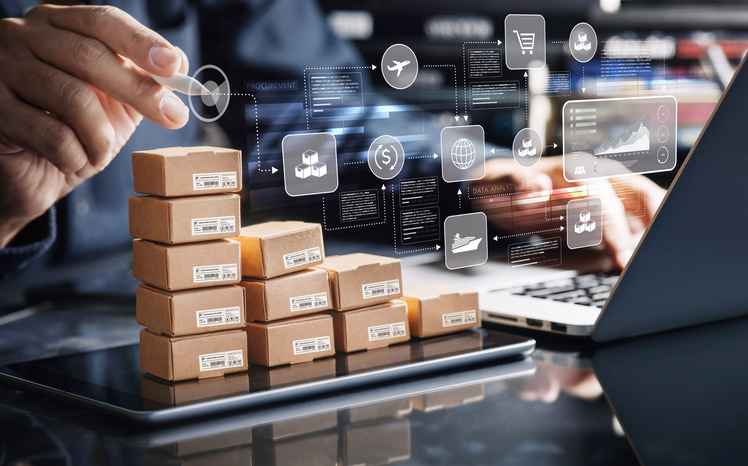While most food manufacturers already have an ERP system in place, many aren’t realizing its full potential or getting the most value possible when it comes to managing the food manufacturing supply chain. Instead, the ERP software system just becomes a “business as usual” tool for core business processes like order processing, accounting and compliance.
But your existing ERP could present a huge opportunity to make your supply chain faster, more agile and more resilient. Statistics show “only 9% of organizations report having realized an ROI since implementing ERP.”
With supply chain disruptions, shifting customer preferences and tight margins, making full use of your ERP system can mean the difference between simply reacting to supply chain fluctuations and proactively addressing the changes before they happen.
Here’s how food manufacturing companies can unlock that value and transform the humble ERP from a back-office system into a dynamic engine for supply chain speed and resilience.

Supply Chain Best Practices
Download this guide to discover 15 supply chain management best practices that can help your company succeed and keep a competitive advantage.
Five Ways to Use Your ERP Software for Supply chain optimization
1. Unlock End-to-End Supply Chain Visibility Already in Your System
Most enterprise resource planning systems have a lot of data that can be utilized to better understand the supply chain. This could include shipment tracking information, production data, and supplier purchase orders. But this visibility often stays siloed in separate ERP modules or is underutilized.
The ERP value opportunity: As part of a value realization strategy, make use of the existing dashboards and analytics tools in your existing ERP to create real-time visibility into the supply chain.
Integrate and visualize data. Ensure your ERP’s inventory, procurement, and logistics modules are connected in order to show live material availability, supplier status, and delivery timelines.
Leverage alerts and KPIs. Take advantage of any real-time alerts your ERP has for critical events like low ingredient stock or delivery delays.
Use traceability features. With product recalls and compliance regulations front and center for food manufacturers, tap into any existing batch and lot-tracking functions to trace ingredients from suppliers to finished goods, strengthening your preparedness for quality control and compliance.
When used effectively, ERP visibility allows for informed decision-making that positively impacts operations. Instead of reacting to problems after they happen, your team can anticipate issues and respond immediately.
ERP value realization: The main benefits include faster decisions, fewer surprises, and improved control over costs and quality.
2. Use Demand Forecasting for Supply Chain optimization
Does your ERP system have forecasting and production planning functionality? Many ERP systems do but a lot of manufacturers only use them occasionally or rely on manually updated spreadsheets. This can lead to gaps or inconsistencies between actual demand and production, resulting in waste, stockouts or overstocks.
The ERP value opportunity: Think of ERP-based forecasting as a continuous process that uses current data to align supply with demand.
Use historical and seasonal data. ERP systems store years of your sales and production data. Analyze trends over time to predict seasonal peaks, promotional increases, or shifts in consumer behavior.
Automate forecast updates. Leverage the automated forecasting feature many platforms have, to automatically adjust forecasts as new sales data flows in.
Integrate with production planning. Use demand forecasts to align production scheduling with procurement to optimize raw material usage and minimize spoilage.
For example, a bakery manufacturer might use its ERP’s forecasting tool to detect an early rise in demand for gluten-free products. Instead of ramping up production reactively, planners can adjust ingredient purchasing and scheduling weeks in advance, reducing rush orders and waste.
ERP value realization: The business value is less waste, lower inventory costs, and the ability to respond faster to changes in customer demand, all without the cost of new software investments.
3. Strengthen Supplier Collaboration Through Centralized ERP Data
Are your teams using email and spreadsheets to communicate with suppliers? Much of this interaction could be automated and run directly through your ERP software.
The ERP value opportunity: Use existing supplier management features within your ERP to create a collaborative supply network with full visibility.
Supplier portals and scorecards. Most ERP platforms offer portal access or shared dashboards where suppliers can view order forecasts, delivery expectations, and performance metrics.
Keep an eye on supplier performance. Use your ERP’s analytics tools to evaluate suppliers on key metrics such as on-time delivery, quality, and responsiveness.
Automate compliance tracking. Instead of manually managing certifications or audits, set automated reminders for renewals within your ERP.
Bring supplier collaboration into your ERP system to eliminate siloed communication and reactive responses to disruptions. If one supplier signals a potential delay, the procurement team can use ERP data to identify alternate suppliers and reassign purchase orders.
ERP value realization: Encourage stronger supplier relationships with fewer delays and greater agility to pivot when challenges happen.

4. Extend ERP Software Automation to Everyday Processes
ERP workflows are often setup during go-live and then never revisited. Over time, any manual processes for functions such as PO approvals, order fulfillment or quality control checks slow operations and are prone to human error.
The ERP value opportunity: Revisit your existing ERP workflows to identify where automation can be expanded or reactivated to eliminate manual steps. For example, automating procurement could drastically reduce delivery time and save cost through operational efficiency. As outlined in an article from Supply & Demand Chain Executive, “we can aim at cost reductions up to 75% through procurement automation, operational efficiency and cutting down delivery time by two days on average.”
Automate Procurement: Consider configuring automatic reorder points based on real-time inventory set points, so materials are replenished just in time.
Production and quality automation: Link shop-floor data capture systems such as IoT sensors, RFID or barcode scanners to your ERP system to automatically log inventory movement, work in process, and machine performance. This creates an end-to-end view that helps ensure that necessary ingredients are available when needed.
Fulfillment automation: Use ERP tools can help you automatically generate shipping labels, invoices, and compliance documents once orders are processed.
Financial and compliance automation: Many ERP solutions can automatically generate traceability reports or cost analyses, reducing administrative tasks and ensuring that you’re ready for audits.
Process automation not only lets your team get more done, faster, but it also improves reliability. Replacing manual entry with automation reduces risk and frees up employees to focus on higher value work.
ERP value realization: More productivity, fewer errors, and less admin hassle, all within your existing ERP system.
5. Turn ERP Data into Continuous Supply Chain Improvement
Your ERP already stores a wealth of supply chain data, including supplier performance, inventory levels and customer demand. Leveraging that data is key to driving continuous improvement across your supply chain.
The ERP value opportunity: Use built-in analytics, dashboards, and reporting tools to reveal trends, identify inefficiencies, and discover new ways to streamline operations.
Find bottlenecks: Monitor lead times, transportation delays, and warehouse throughput to pinpoint slow-moving processes.
Optimize quality and reduce waste: Examine return data, damaged goods, or supplier defect rates to improve quality control and minimize losses.
Manage Costs: Compare planned vs. actual logistics, sourcing, and production costs to refine budgets and improve margins.
Rather than using disparate systems or one-off spreadsheets, you can rely on existing insights from your ERP to build a culture of continuous improvement based on data-driven decisions tied to measurable supply chain outcomes.
ERP value realization: Gain more supply chain resilience, lower costs, higher efficiency, and a clear ROI on your ERP investment.
Ready to start your digital transformation journey?
The Next Phase of ERP Value Realization for Supply Chain Optimization
Go-live isn’t the end of an ERP project. Even after implementation is completed, there’s still room to refine, optimize and extend what the system delivers. For manufacturers, and food manufacturers specifically, the question should shift to “How can we get more value from what our ERP is doing?”
The challenge, and the opportunity, is to unlock its full potential.
By re-evaluating existing capabilities of your ERP, you can turn it into a catalyst for a fast, resilient supply chain. Through optimizing visibility, forecasting, collaboration and automation functionality, your company can:
- Respond faster to demand fluctuations
- Establish stronger supply partnerships
- Reduce waste and cost
- Gain greater agility to supply chain disruptions
Ultra's ERP Value Realization Services
Ultra Consultants can help maximize the value of your enterprise resource planning software, enhancing existing capabilities to optimize supply chain operations. Our post-implementation enhancements, continuous improvement initiatives, and targeted training can deliver high-value benefits and deliver improved ROI from your ERP—all tied to your business objectives. Want to learn more about Ultra Consultants’ Value Realization process? Get started today by requesting your free, no-obligation discovery call.
Table of Contents
More ERP material...
Assessing Your AI Maturity
This article breaks down how businesses can measure their AI maturity to…
Why You Should Hire a Business Process Improvement Expert to Kick Off Your AI Business Transformation
AI won’t fix broken processes; it’ll just make the chaos run faster.…
How Food Manufacturers Can Use Existing ERP to Optimize Supply Chains
Food manufacturers often underuse their ERP systems, missing opportunities to strengthen supply…


